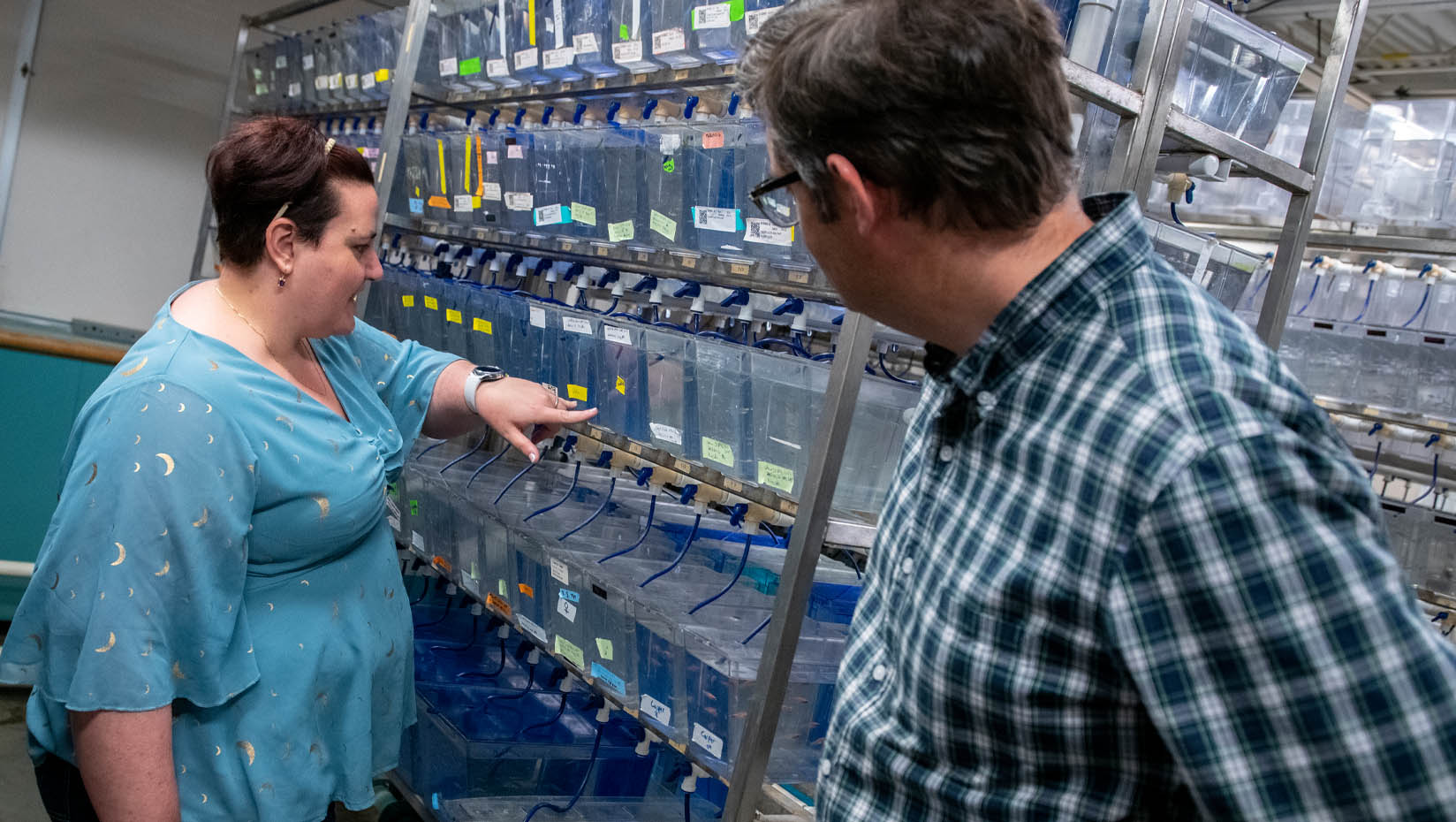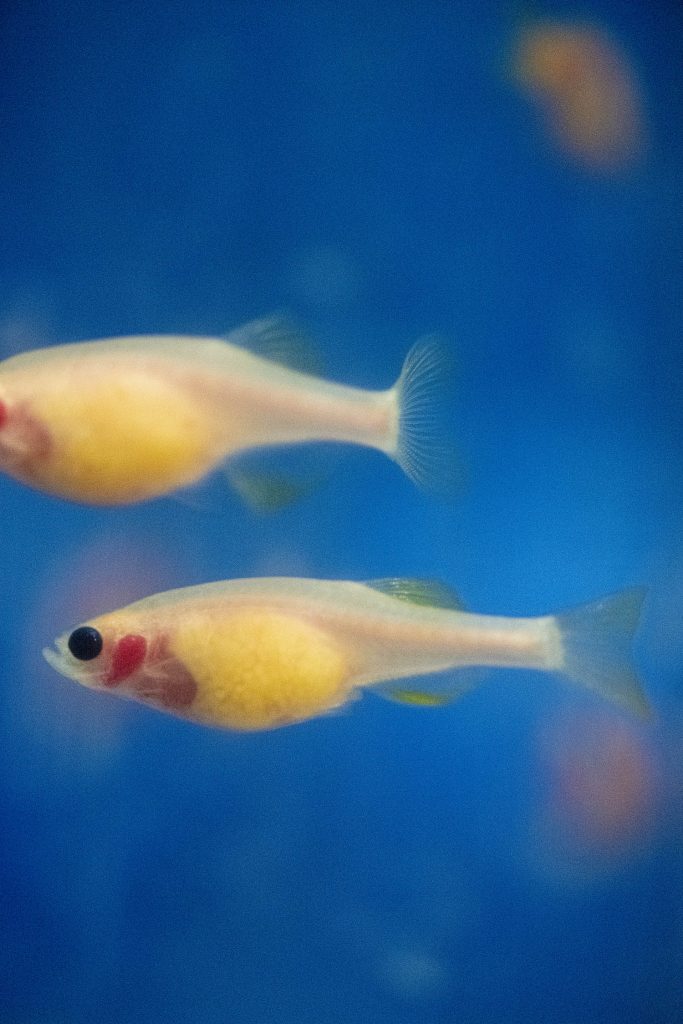
The University of Maine’s zebrafish facility is a bastion of research
In the two adjacent rooms, the air is thick with an almost tropical humidity and a quiet gurgling sound comes from a complex circulating water system. Inside, racks of tanks hold tens of thousands of tiny fish. They are all zebrafish — an inch-long relative of the minnow native to South Asia — but a close look reveals their variations: transparent “Casper” zebrafish; fish dyed with purple, red and green markers; and fish with spots instead of stripes, or long flowing fins in place of the stubbier standard set.
The impressive set-up comprises the University of Maine’s Zebrafish Facility, which was the first of its kind in Maine when it launched in 2003. Four years ago, it became a Coordinated Operating Research Entities (CORE) unit, providing research and development resources for Maine and beyond.
UMaine was one of the first institutions in New England to use the zebrafish as a model organism for research looking at everything from muscular dystrophy to bacterial infections. Over the past two decades, researchers at the University of Maine have made groundbreaking discoveries with these tiny fish — and they are just getting started.
Zebrafish have many advantages as a model organism. They have been used for over a century to study developing embryos because their fertilization and development are external, and the embryos are translucent and easy to manipulate. Zebrafish genomes are similar to humans, particularly their immune systems, but they mature quickly, mate in large batches and their genes are easy to tinker with for genetic research.

Compared to other common model organisms like mice, zebrafish are also inexpensive and space efficient. UMaine’s Zebrafish Facility is a testament to that, boasting 21 recirculating racks of tanks for genetics and development work in its main 20 by 30 foot room in Hitchner Hall, plus another room next door with seven racks of tanks and one isolated rack for disease and toxicology research. There are a total of 1,700 tanks 3- and 10-liter tanks throughout the system, with space for over 30,000 zebrafish.
Before the facility was set up in its current iteration, former UMaine professor Carol Kim had managed several tanks for her own research on the innate immune response to pathogens and environmental toxicants starting in 1999. Kim, who eventually served as the director of the Graduate School of Biomedical Science and Engineering and university’s Vice President for Research, spearheaded the effort to expand the facility to include more researchers.
Mark Nilan, the facility’s operations manager, worked with the UMaine Center for Cooperative Aquaculture Research to set up the lab in 2003 while completing his undergraduate degree in aquaculture (a program that was eventually restructured into a certificate in 2007).
“In the early days when they set up these labs they would just put people who had a fish tank and that was a disaster,” Nilan says. “UMaine set up for success with its certification in aquaculture.”
Nilan said that current system is more analog than many modern zebrafish lab set ups — he balances the pH of the water himself instead of digitally, for example — but that hands-on approach is part of what he believes has kept the lab from having any major incidents of zebrafish mortality since he has managed it. He recruits students through the aquaculture minor at the School of Marine Sciences for daily “animal husbandry” tasks like cleaning tanks, performing maintenance and feeding the fish. The Institutional Animal Care and Use Committee regularly checks on the lab to ensure its animal subjects are treated ethically and humanely.
Though the facility in and of itself is impressive, the research and education done there is perhaps even more so. Robert Wheeler, associate professor in the Department of Molecular & Biomedical Sciences and faculty liaison for Zebrafish Facility, said that there are currently five labs at the University of Maine that are “100% committed to working with zebrafish.” His lab uses zebrafish to study fungal pathogens in hospital settings. Ben King uses zebrafish for genetics projects in his bioinformatics lab, while Melody Neely’s lab studies host-pathogen interactions during bacterial infections. Clarissa Henry uses zebrafish to study muscular dystrophy, and Jared Talbot’s lab uses zebrafish for research on muscle development (he has just won an award for his efforts to share zebrafish with the scientific community).
The facility also supports teaching at the School of Biology and Ecology, Molecular and Biomedical Sciences at the Hutchinson Center in Belfast by, for example, providing zebrafish embryos to classes studying early development. Researchers across the country can order zebrafish embryos from the facility, too.
Since 2017, the UMaine zebrafish facility has earned over $7.2 million in extramural funding from the National Institutes of Health, National Science Foundation and Burroughs Wellcome Fund, as well as over $104,000 in intramural funding from the University of Maine and University of Maine System. Over 90 undergraduates have been trained through the lab for highly skilled jobs and graduate school at prestigious institutions, as well as 35 graduate students and 1 post-doctoral fellow. The facility has produced 42 peer-reviewed publications in journals like Nature, Cell Reports, Cell Host & Microbe and eLife. The facility has conducted community outreach with over 120 high school students. Students who collaborated with Henry to use the facility’s zebrafish won first place in eCYBERMISSION, a virtual STEM competition for grades 6-9.
Wheeler expects the success of the facility will only grow as zebrafish become an increasingly popular model organism. He says there are grants in the works to “significantly increase” the size of the UMaine Zebrafish Facility by adding more rooms for racks in Hitchner Hall.
“One of the things that happens when the community keeps growing is that there are more and more tools that get developed, more and more foundational knowledge that gets discovered. The combination fuels a more rapid science that attracts more people, builds more tools and this feeds back again.”
Contact: Sam Schipani, samantha.schipani@maine.edu
